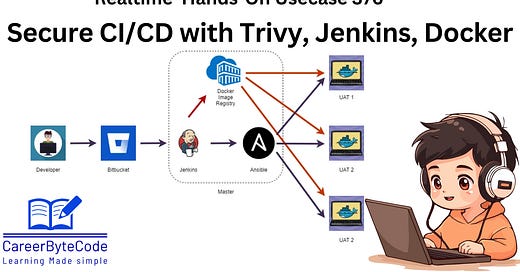From Bare Metal to Build-Ready: Setting Up Jenkins & Docker with Ansible
Trivy, Java, Maven, and more all in one streamlined playbook
1. Problem Statement
In the dynamic world of DevOps, speed, consistency, and scalability are critical. Setting up a complete CI/CD ecosystem including tools like Java, Maven, Docker, Jenkins, and Trivy on freshly launched EC2 instances often involves multiple manual steps. This traditional approach is not only time-consuming but also increases the risk of human error, version mismatches, and configuration drift.
Current Challenge:
Manual setup of CI/CD tools on multiple EC2 instances is repetitive and error-prone.
Ensuring consistent configurations across environments is difficult.
Scaling the setup or replicating it in new environments requires rework and documentation.
Objective:
To automate the provisioning, configuration, and validation of a complete CI/CD toolchain on AWS EC2 instances using Ansible, enabling:
Faster and repeatable infrastructure setup.
Consistent tool versions and configurations.
Infrastructure as Code (IaC) practices for better manageability and scalability.
This automation not only saves time but also lays the foundation for a robust, production-ready DevOps environment with minimal manual intervention.
2. Why We Need This Use Case
In the world of DevOps, toolchain automation is crucial for minimizing errors and accelerating setup times. Manual installations of Jenkins, Docker, Java, Maven, and security tools like Trivy on multiple EC2 machines are time-consuming and error-prone. Every time a new EC2 instance is launched, repeating these tasks becomes inefficient.
Using Ansible with role-based modular automation, you can achieve:
Idempotent configurations: The playbooks can be rerun without breaking existing setups.
Consistent environments: Ensures all machines have the same software versions and configurations.
Infrastructure as Code (IaC): Configuration is version-controlled, repeatable, and scalable.
Faster onboarding: New build machines or Jenkins agents can be ready in minutes.
Security validation: With Trivy integrated, vulnerability scanning is automatic during setup.
This use case directly supports CI/CD maturity, production-readiness, and DevOps excellence.
3. When We Need This Use Case
This use case becomes essential when:
You are launching new AWS EC2 instances for a CI/CD environment.
Your team wants repeatable and error-free deployments of common DevOps tools.
You need fast infrastructure provisioning to scale Jenkins agents or Docker build servers.
You are migrating from manual setups to Infrastructure as Code practices.
You’re running multi-environment configurations (dev, staging, prod) and want consistent setups.
You want to train teams or students on real-world infrastructure automation with Ansible.
4. Challenge Questions
Keep reading with a 7-day free trial
Subscribe to CareerByteCode’s Substack to keep reading this post and get 7 days of free access to the full post archives.






